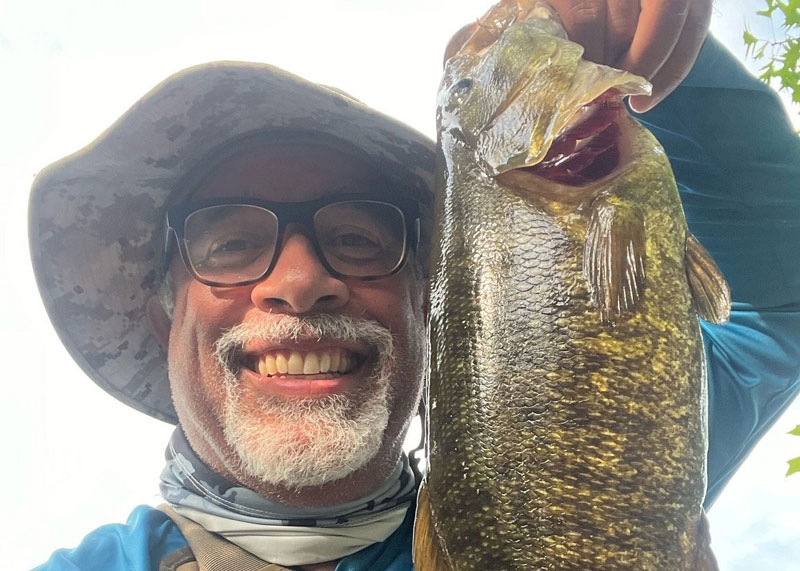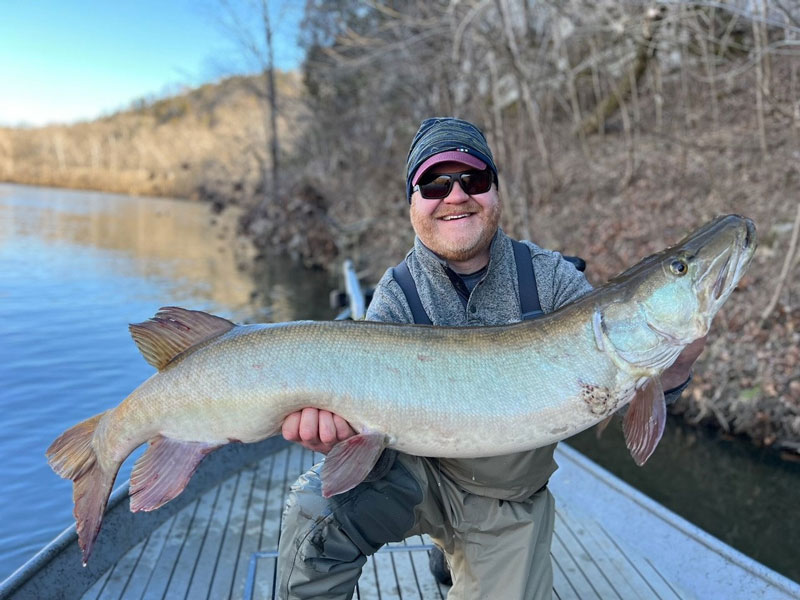Smallmouth bass, walleye, and muskie are three exciting species of gamefish that freshwater anglers can target above the fall line of the Chesapeake region’s Western Shore rivers. The states of Maryland, Virginia, and Pennsylvania all contribute to feeding Chesapeake Bay with its lifeblood of freshwater. Water on the Eastern Continental Divide gathers then flows down to the Bay, and between the fall lines of these rivers and their upper reaches you’ll find a variety of temping opportunities.
Smallmouth Bass

You can find smallmouth bass in most, if not all, of the Western Shore rivers feeding the Bay, although they are not native to Maryland. They were introduced in the mid-1850s by employees of the B&O Railroad company. Some 20 fish from the Wheeling River in West Virginia were introduced into the C&O Basin in Cumberland at that time. And boy am I happy that they did it. Smallmouth bass are pound-for-pound one of the best fighting fish out there, especially in a river’s current.
You can find them in areas with rocky, gravel, and sandy bottoms. Catch them by casting baits into eddies, over gravel or substrate, and in shaded areas along the shoreline. Cast next to fallen trees and around logjams, too. Look for deeper pools where you have swift water, casting into the faster water and working the seam where the water becomes smooth and flat.
I use light spinning tackle and cast one of my favorite baits, a Ned rig, dressed with plastics that are various darker browns or hues of blue and gray, as well as plastics that mimic a crayfish. Crankbaits with a crayfish pattern worked across deeper pools produce fish, too. You can also throw square-billed crankbaits, bouncing them over gravel bottoms or rocks. Use a deeper diving bait if you locate deep flats or pools. Jerkbaits with patterns of minnows or creek cubs also work well.
Top Smallmouth Hotspot
The upper Patuxent or Patapsco Rivers. Throw a pair of hip waders in the truck, then head to Laurel or the Daniels area and cast smaller baits and inline spinners. Though most of the fish in these areas will be on the smaller side they are quite prolific and as I said, smallmouth bass are one of the hardest fighting fish around — catching lots of small ones can be a ball.
Walleye

Walleye were first introduced to the Potomac River in 1979. A 2019 Maryland DNR study found that walleye range from Cumberland, MD, to Washington, DC, with the highest concentration between Harpers Ferry and Clear Springs. Walleye will gather at the base of the river dams during their spring spawn, then spread out downriver as the summer weather moves in. You can find them over rocky bottoms or sandy substrate. They can also be found in some numbers at the base of the Conowingo Dam on the Susquehanna River. Walleye are native to the Clinch and Holston rivers in Virginia, and today can also be found in the New, Stanton, and Dan.
Casting small paddletail jigs and jerkbaits into cuts, deep holes, around boulders, and eddies with a rocky bottom will produce fish. Look for them where cool creeks enter the river. Early morning is a good time to cast on them, but evening is their preferred time to eat. During the summer look for walleye near the mouths of and up inside spring-fed creeks, too.
Top Walleye Hotspot
The Potomac River near and around Great Falls. Try casting jerkbaits into eddies and pools and remember that walleye tend to bite best early in the morning and late in the evening.
Muskellunge

Okay, let’s talk about Muskie. This is one fish that anglers are quite tight lipped about, they handle with kid gloves, rarely take a photo of and if they do they have the background blurred out. Why? This is the “fish of 10,000 casts.” Muskie are the largest of fish in the esox family, they can live as long as 20 years and grow up to 50-plus inches. Being a top apex predator, they exist in relatively low densities. If you are fortunate enough to catch one, hang on for one of the best fights you’ll ever have with any freshwater sportfish.
Like smallmouth and walleye, muskie are not native to most of the region. In Maryland they are only found in the Potomac River, first reported there in 1996. No one seems sure how or when they were introduced, and there are just a few locations to hunt for them along the river. The highest density of muskie is in the Washington County portion of the river. The James River in Virginia is often considered a world class muskie fishery, with fish first stocked in the state in 1960s and now reproducing naturally in some areas.
If you haven’t yet fished for muskie my recommendation would be to seek out a guide who can help you reduce that 10,000 casts number. Guides will know the river, the specialized gear, and how to safely handle the fish once boated. If you do venture out on your own, you’ll need a rod and reel that can handle very large baits. Typically you’ll want a 300 to 400 baitcaster spooled with 80-pound braid, heavy leader in the 60-pound class or bigger, with an eight- or nine-foot heavy action rod. You will have to determine the appropriate rod length for your use; if you’re fishing from a kayak a shorter rod is appropriate. All of this isn’t just due to the fight or size of the fish, it’s also due to the baits you’ll need to use. These are big lures with large, thick hooks, such as nine- to 12-inch plugs and size 20 spinners. And don’t forget to take along the proper sized net, too.
Top Muskie Hotspot
The James River above Lynchburg, VA. When fishing from a boat remember to always do a “figure eight” with your rod at the end of your retrieve because muskie are known for following a bait right up to the boat. Doing the figure eight before recasting leads to a lot of strikes.
- By Eric Packard
Targeting walleye, smallmouth, and muskie is a must in my book — each of these fish are worth getting excited about. If you haven’t yet cast on them, now is the time to make a trip above the fall line.
Mini-Sidebar: Waiting for Fall
We included muskie in this article because they’re such a cool fish to catch when you’re fishing above the fall line, but the timing is off — August is not the best time to hunt for muskellunge. They are a relatively fragile fish during summers as they do not tolerate heat well, and they have a high July-August mortality rate according to studies performed in the James River. Anglers are encouraged to wait until the heat of summer has passed to pursue them.